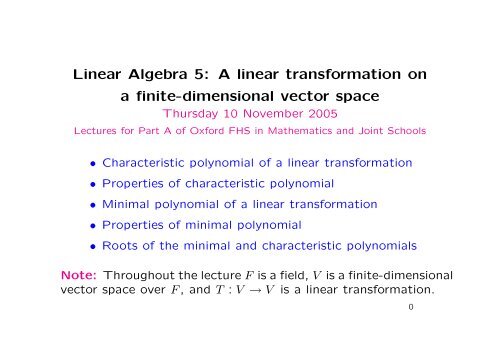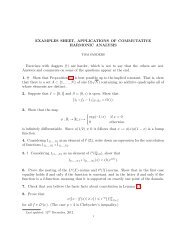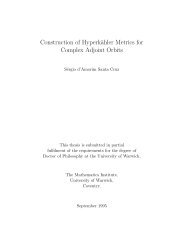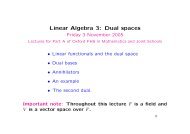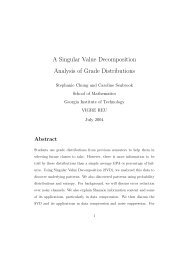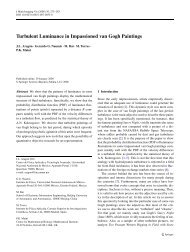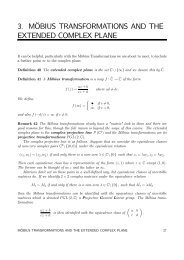Linear Algebra 5: A linear transformation on a finite-dimensional ...
Linear Algebra 5: A linear transformation on a finite-dimensional ...
Linear Algebra 5: A linear transformation on a finite-dimensional ...
Create successful ePaper yourself
Turn your PDF publications into a flip-book with our unique Google optimized e-Paper software.
<str<strong>on</strong>g>Linear</str<strong>on</strong>g> <str<strong>on</strong>g>Algebra</str<strong>on</strong>g> 5: A <str<strong>on</strong>g>linear</str<strong>on</strong>g> <str<strong>on</strong>g>transformati<strong>on</strong></str<strong>on</strong>g> <strong>on</strong><br />
a <strong>finite</strong>-dimensi<strong>on</strong>al vector space<br />
Thursday 10 November 2005<br />
Lectures for Part A of Oxford FHS in Mathematics and Joint Schools<br />
• Characteristic polynomial of a <str<strong>on</strong>g>linear</str<strong>on</strong>g> <str<strong>on</strong>g>transformati<strong>on</strong></str<strong>on</strong>g><br />
• Properties of characteristic polynomial<br />
• Minimal polynomial of a <str<strong>on</strong>g>linear</str<strong>on</strong>g> <str<strong>on</strong>g>transformati<strong>on</strong></str<strong>on</strong>g><br />
• Properties of minimal polynomial<br />
• Roots of the minimal and characteristic polynomials<br />
Note: Throughout the lecture F is a field, V is a <strong>finite</strong>-dimensi<strong>on</strong>al<br />
vector space over F , and T : V → V is a <str<strong>on</strong>g>linear</str<strong>on</strong>g> <str<strong>on</strong>g>transformati<strong>on</strong></str<strong>on</strong>g>.<br />
0
Determinants<br />
Recall from Mods: Det A and Trace A of a square matrix A.<br />
Definiti<strong>on</strong>: Define the determinant of T by Det T := Det A,<br />
where A is the matrix of T with respect to some basis of V .<br />
Similarly, define the trace by Trace T := Trace A.<br />
Observati<strong>on</strong>: Determinant and trace of T do not depend <strong>on</strong> the<br />
basis of V . They depend <strong>on</strong>ly <strong>on</strong> T .<br />
Proof.<br />
1
The characteristic polynomial<br />
Definiti<strong>on</strong>: The characteristic polynomial of an n × n matrix A<br />
is defined by<br />
c A(x) := Det (xI − A) .<br />
The characteristic polynomial of T is defined by C T (x) := C A(x)<br />
where A represents T with respect to some basis of V .<br />
Note: If n := dim V then c T (x) is a m<strong>on</strong>ic polynomial (m<strong>on</strong>ic<br />
means leading coefficient = 1), and it is of degree n. In fact<br />
where<br />
c T (x) = x n − c1x n−1 + c2x n−2 − · · · + (−1) n cn ,<br />
c1 = Trace T , cn = Det T, etc.<br />
2
Properties of the characteristic polynomial<br />
• c T (x) is well defined (independent of basis).<br />
• If S = U −1 T U, where U : V → V is <str<strong>on</strong>g>linear</str<strong>on</strong>g> and invertible,<br />
then c S(x) = c T (x).<br />
• Roots of c T (x) are the eigenvalues of T .<br />
• If λ ∈ F is an eigenvalue of T then ∃v ∈ V such that v = 0<br />
and T v = λv, that is, there exists an eigenvector for T with<br />
eigenvalue λ.<br />
• C<strong>on</strong>versely, if v is an eigenvector for T , so that v = 0 and<br />
∃λ ∈ F such that T v = λv, then c T (λ) = 0.<br />
3
The minimal polynomial, I<br />
Lemma. Let n := dim V . The set of all <str<strong>on</strong>g>linear</str<strong>on</strong>g> <str<strong>on</strong>g>transformati<strong>on</strong></str<strong>on</strong>g>s<br />
S : V → V is a vector space of dimensi<strong>on</strong> n 2 .<br />
Proof.<br />
Polynomial functi<strong>on</strong>s of T : for f(x) = a0+a1x+· · ·+a kx k ∈ F [x]<br />
we define f(T ) := a0I + a1T + · · · + a kT k , where I : V → V is<br />
the identity map.<br />
Note: if f, g ∈ F [x] then f(T )g(T ) = g(T )f(T ).<br />
4
The minimal polynomial, II<br />
Lemma. There is a polynomial f ∈ F [x]\{0} such that f(T ) = 0.<br />
[Similarly for n × n matrices.]<br />
Proof.<br />
Definiti<strong>on</strong>. A m<strong>on</strong>ic polynomial f ∈ F [x] \ {0} of least degree<br />
such that f(T ) = 0 is known as the minimal polynomial of T .<br />
[Similarly for n × n matrices A.]<br />
Examples. m I(x) = x − 1; m0(x) = x; if A =<br />
then m A(x) = (x 2 − 3x + 2).<br />
⎛<br />
⎜<br />
⎝<br />
1 0 0<br />
0 2 0<br />
0 0 2<br />
5<br />
⎞<br />
⎟<br />
⎠
Properties of the minimal polynomial, I<br />
• Minimal polynomial is unique.<br />
• We’ll write m T (x) (or m A(x) when A is an n × n matrix<br />
over F ) for the minimal polynomial.<br />
• If A ∈ Mn×n(F ) and A represents T with respect to some<br />
basis of V then m T (x) = m A(x).<br />
• If S = U −1 T U, where U : V → V is <str<strong>on</strong>g>linear</str<strong>on</strong>g> and invertible,<br />
then m S(x) = m T (x).<br />
6
Properties of the minimal polynomial, II<br />
Theorem. For f ∈ F [x], f(T ) = 0 if and <strong>on</strong>ly if m T (x) divides<br />
f(x) in F [x]. [Similarly for A ∈ Mn×n(F ).]<br />
Proof.<br />
7
Roots of the minimal polynomial<br />
Theorem. For λ ∈ F , m T (λ) = 0 if and <strong>on</strong>ly if c T (λ) = 0.<br />
[Similarly for A ∈ Mn×n(F ).]<br />
Proof.<br />
Example. A =<br />
⎛<br />
⎜<br />
⎝<br />
1 0 0<br />
0 2 0<br />
0 0 2<br />
m A(x) = (x − 1)(x − 2).<br />
⎞<br />
⎟<br />
⎠ . Here c A(x) = (x − 1)(x − 2) 2 and<br />
Note: in fact m T (x) and c T (x) always have the same irreducible<br />
factors in F [x].<br />
8


